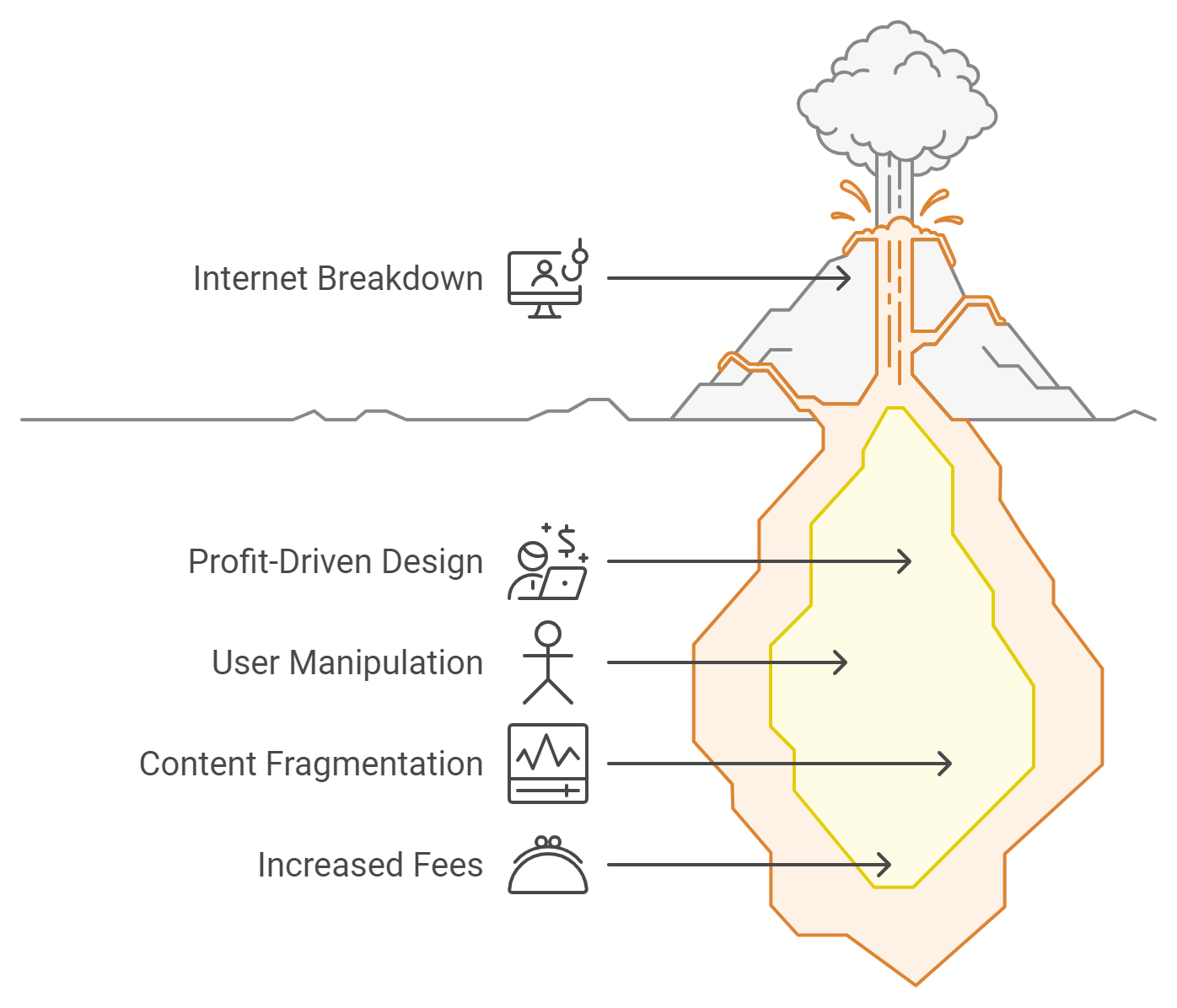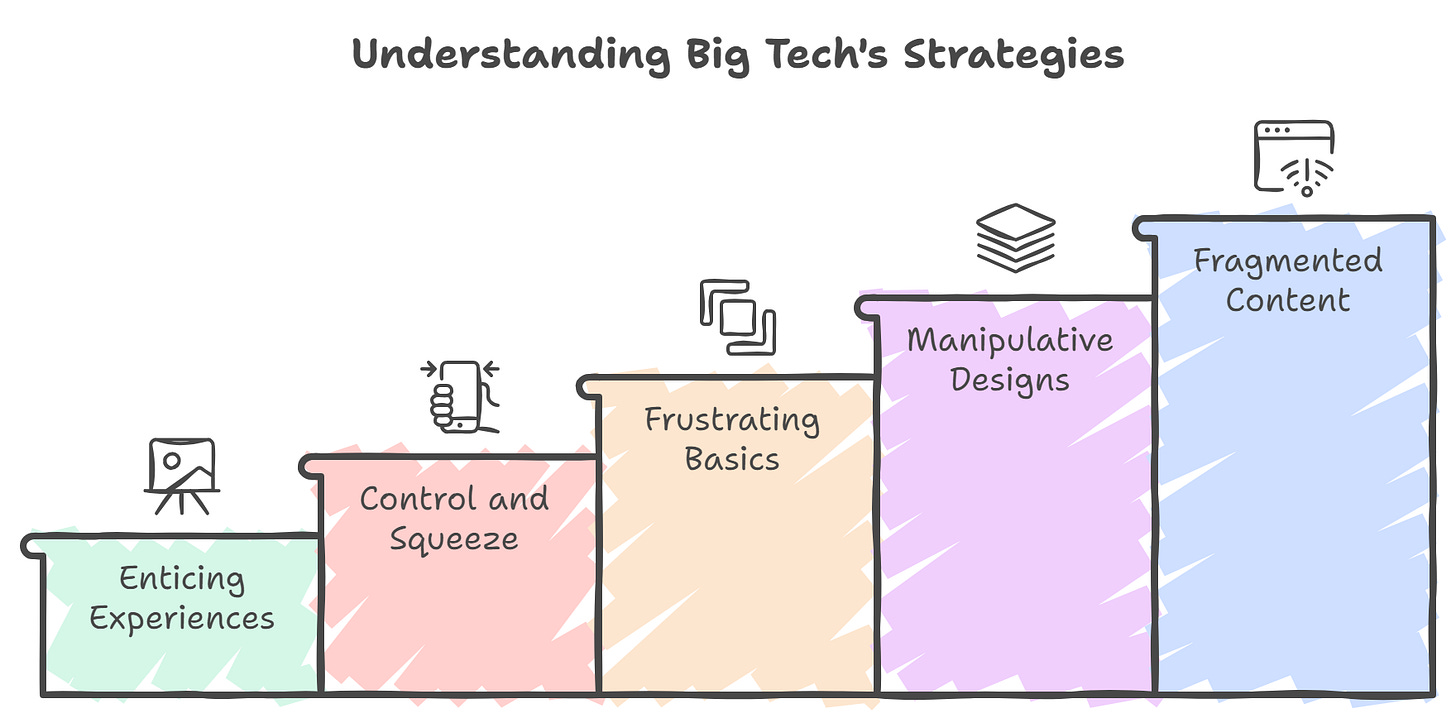How Big Tech Broke the Internet for Profit: The Hidden Playbook
Explore how tech giants turned from user-first to profit-first, using dark patterns, hidden fees, and frustrating tiers to maximize revenue.
What if the apps and services you rely on every day like Uber, Amazon, and Netflix were quietly being redesigned to make your experience worse, all in the name of profit? Why is it that the platforms that once made our lives incredibly convenient now seem riddled with obstacles and fees?
Let’s dive into why the internet, dominated by tech giants, feels like it's breaking and how the shift from "user-first" to "profit-first" is turning our favorite apps into our biggest frustrations.
1. The Three Phase Process of Big Tech
It starts with a promise. Every major tech company goes through three phases to dominate the market:
Phase 1: The Golden Era
When Uber launched in 2009, it felt revolutionary. Clean cars, friendly drivers, and rides at half the price of a traditional taxi. Everything was centered around the user, delivering an exceptional experience to gain loyalty.Phase 2: Catering to Suppliers
Once users were hooked, these companies turned to focus on suppliers. For Uber, it meant attracting and retaining drivers with high earnings, bonuses, and incentives like surge pricing. But make no mistake, this was all about making sure they could control the supply side effectively.Phase 3: The Profit Grab
Once both sides, users and drivers, were locked in, came the final stage: maximizing monetization. Uber began squeezing both. Riders saw higher fares, less transparency, and more fees, and drivers saw their earnings shrink as Uber increased its cut. Suddenly, everyone’s experience was worse, but neither side had better options.
💡 Key Insight: The three phase process is a playbook across big tech to create an amazing experience to hook users, lock in suppliers, and then squeeze both for profit. It’s definitely not a glitch and it’s a system working exactly as planned.
2. Tiering and Subscriptions: More Money, Less Value
The rise of tiering isn’t about making premium services better. It’s about making the standard experience worse until you're forced to pay more.
Take Netflix, for instance. It started as a simple, affordable way to watch ad-free content. Today, you need to pay more for 4K or to avoid ads. The base subscription feels less like an option and more like an inconvenience you’re nudged to "upgrade" from.
Uber and other services employ a similar strategy. The best cars, shortest wait times, and preferred drivers are reserved for those willing to pay a premium. It’s not that the premium service is getting better, it's that the basic service is intentionally degraded.
💡 Key Insight: Tiering and subscriptions have become tactics to extract as much as possible from users, rather than to genuinely improve the product. The idea is simple: pay up, or suffer the frustration.
3. Dark Patterns: How Big Tech Manipulates You
Big tech companies use psychological tricks known as dark patterns to manipulate user behavior and make it harder to leave. Here are a few common tactics:
Confusing Design: Want to cancel a subscription? Get ready to navigate multiple pages where the "Cancel" button keeps changing its position, subtly nudging you to click "Continue" instead.
Subscription Loops: Canceling isn’t always straightforward. Sometimes, you're given an option to "pause" rather than cancel. It’s deliberate, hoping you'll forget to return and cancel later.
Hidden Fees: Uber Eats, for example, adds fees at every stage: delivery, small order, priority delivery, making it almost impossible to understand the real cost of what you're paying.
💡 Key Insight: Dark patterns are designed to trick you, making it difficult to unsubscribe, add more charges, and ultimately keep you trapped in the system.
4. The Fragmentation of Content: Too Many Subscriptions
Once upon a time, you could watch all your favorite shows on a single Netflix subscription. Now, you need Disney+, HBO Max, Apple TV+, and Amazon Prime just to keep up. The result? Fragmentation has driven up the cost of content consumption while decreasing its convenience. The simple streaming experience we once loved has turned into a costly, disjointed mess.
💡 Key Insight: The rise of fragmented subscription services means higher costs, more frustration, and less value for consumers. We’re paying more to get a worse experience.
Key Takeaways:
The Three Phase Process: Tech giants lure users in with great experiences, then squeeze both users and suppliers once they have control.
Tiering and Subscriptions: Instead of making premium options attractive, they make basic services frustrating to nudge users to pay more.
Dark Patterns Everywhere: Big tech companies use manipulative designs to keep you locked into services you might not even want.
Content Fragmentation: Multiple subscription services are forcing consumers to pay more while making streaming more cumbersome than ever.
In Closing:
The tech giants that once improved our lives are now breaking the internet they helped build. Services like Uber, Amazon, and Netflix have pivoted from delivering groundbreaking user experiences to maximizing profits, at the cost of their users. What started as convenience and innovation has turned into frustration, confusion, and ever-increasing costs.
The reason the internet feels like it's breaking is because it is. It's being broken by a model that values revenue over experience, margins over convenience, and profit over people. If we want a better internet, we need companies that put users at the forefront, not at the bottom of their balance sheet.
Disclaimer: The information provided by Insight Labs is for educational purposes only. It is not intended to be, and should not be taken as, legal, tax, investment, financial, or any other form of professional advice.









